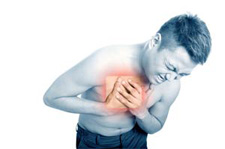Atypical Chest Pain

How Serious Is Atypical Chest Pain?
A Definition of Atypical Chest Pain - First of all, a definition of atypical chest pain is in order. Typical chest pain is a pain that is felt directly beneath the chest bone, or sternum. Typical chest pain may spread across the chest and beyond, but is centered in the middle of the chest. Atypical chest pain is not centered behind the sternum, but is usually to the right or to the left. The boundary between the two types of chest pain is a little fuzzy, and in many instances it can be difficult to tell which type a person may be experiencing.
Many Causes Of Atypical Chest Pain - Chest pain can be a cause of concern. It should be, as chest pain is often a symptom of a serious disorder, usually affecting the heart. An atypical chest pain can also be traced to something seriously wrong with the heart. The problem is, an atypical chest pain can be the result of any number of disorders, some of them serious, many of them not.
People who have a lower threshold of pain are more apt to see a doctor when they experience an atypical chest pain, as the pain seems to them to be severe enough to warrant a trip to the doctor's office, or even to the emergency room. Women experience atypical chest pains more often than do men. In fact, men normally experience typical chest pain, centered under the sternum, when having a heart attack. Women on the other hand, more often experience pain in the shoulder, jaw, neck, and even in the upper back, when having a heart attack – an atypical chest pain.
The danger then is that atypical chest pain is often misdiagnosed, or not looked into at all. In most cases nothing bad may come of this, as atypical chest pains tend to be due to musculoskeletal problems, and not problems associate with the heart or the lungs. But there are enough instances where an atypical chest pain is directly the result of blockage or obstruction of an artery, that each and every case needs to be examined carefully.
Sources - The source of a pain in the chest, typical or atypical, can come from the heart, the aorta, the ribs, the esophagus, and even the skin. The nerves associated with some of these sources follow common paths to the central nervous system, making the source of the pain very difficult to locate at times. Atypical chest pain can be caused by pneumonia, a situation which is generally easy to diagnose. Pain can also be caused by hyperventilation which can accompany an anxiety or a panic attack. Here cause and effect tend to become intertwined.
Blockages of smaller blood vessels surrounding the heart can result in chest pain, at times atypical pain. This condition, referred to as myocardial ischemia, is not particularly severe, but painful and worrisome nevertheless. Acid reflux disease can cause heartburn, a symptom usually not confused with angina, or any pain due to a condition of the heart, but in some instances the disorder can cause muscle spasms, which can be interpreted as being true chest pains. Another type of chest pain, often felt only on one side, but sometimes both, is when the lining protecting the lungs becomes inflamed. This condition, though not usually serious, can cause significant pain in the chest area.
In summary, atypical chest pain is more often than not the result of a gastrointestinal, pulmonary, or even a psychological disorder, which may or may not be serious. It can also result from a cardiac or vascular disorder, which of course can be very serious indeed. Just because a pain in the chest is not what might be expected as far as something being wrong with the heart is concerned, in other words it is atypical, does not mean it is not serious. No matter what the cause, it should be looked into, especially if it is recurrent, and increasing in severity or frequency.